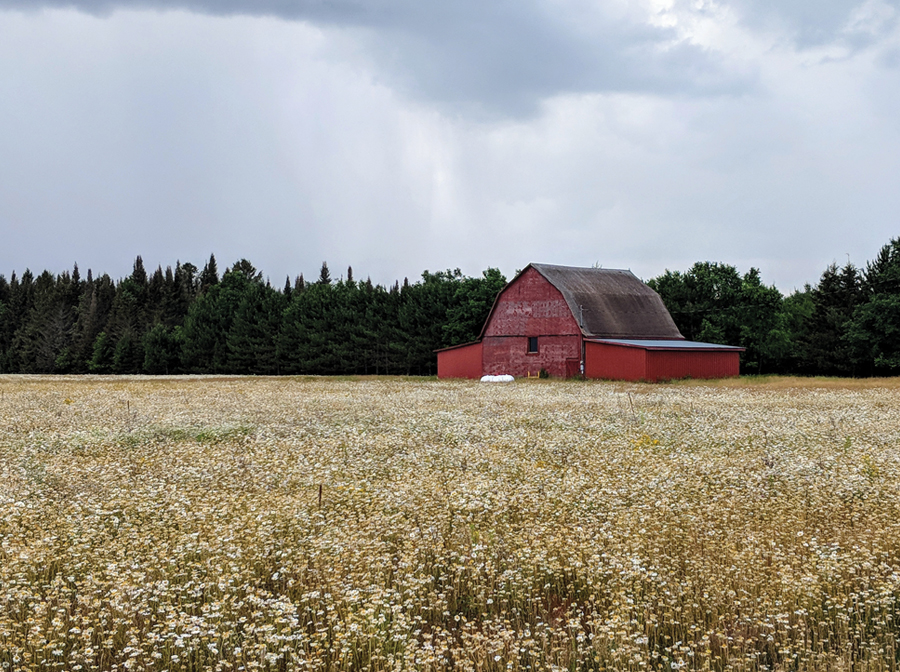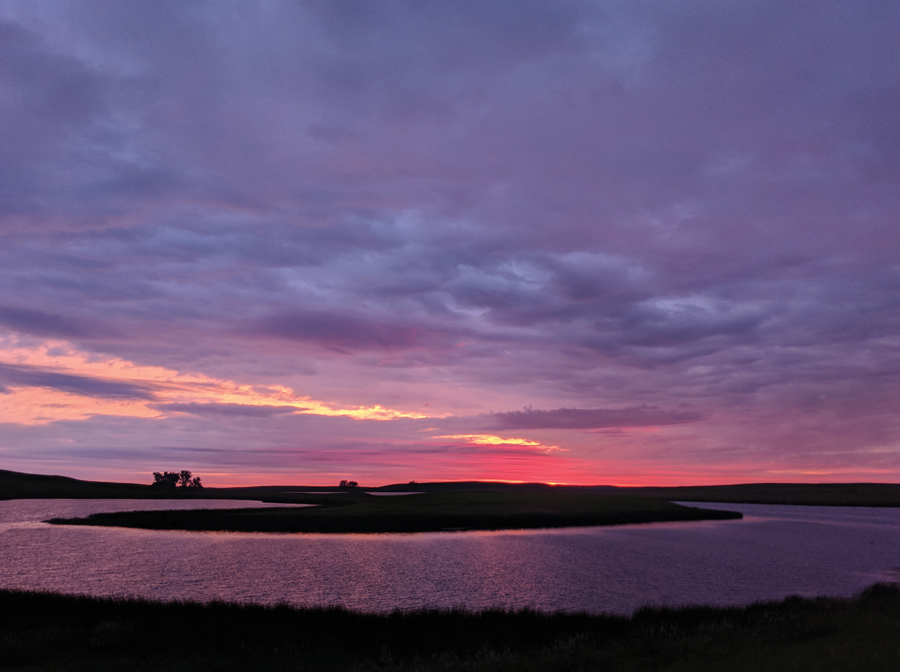A Stroke of Luck
This story originally appeared in the December 2020/January 2021 issue of Adventure Cyclist magazine.
Ka-chunk, ka-chunk, ka-chunk. The unsettling song of chain chatter was a vibrant memory and an unwelcome worry on this journey. “Oh no,” I said. I stopped to inspect. No evidence of malfunction.
Back in the saddle, I pushed the cranks forward.
Ka-chunk, ka-chunk, ka-chunk. Worry morphed into frustration. How could I continue moving this machine when each pedal stroke resulted in a confounding jolt in the chain? I realized that one of my legs was not pedaling the same as its mate.
“Can you two please coordinate your efforts?” I asked. “We have just 10 more miles to town.” The urgency deepened as I urged muscular cooperation. After a few nights of camping, a reserved motel room awaited this overused collection of human and metal machinery. It had been a hot and hilly day on the eastern shoreline of colossal and scenic Lake Michigan. I was pedaling as the sun rose over the Sleeping Bear Dunes National Lakeshore. It was my middle child’s 24th birthday. I paused at an open meadow to send well wishes to the East Coast. The message time stamp was 7:01 am CDT, Wednesday, July 17, 2019.
Later, having traveled 80 miles farther south, the afternoon sunlight delivered excessive warmth and my solitude was replaced by ka-chunk, ka-chunk, ka-chunk. “Eight miles to go,” I told myself while questioning whether I was suffering heat symptoms. “Eight more miles.” A motivating mantra. I would cool down, properly replenish my water reserves, rinse my body of accumulated salt deposits and road filth, fuel my weary muscles with mounds of town food, and sleep peacefully in a clean bed topped by a real pillow.
“Wait, wait … what’s … ” I abruptly lost control of the bike.
CRASH.
Utter confusion. “Did that just happen? What is going on with me?” I found myself lying downhill on a slope ending at a drainage ditch, still clipped into the bike with my right leg awkwardly pinned underneath it. My immediate concern was not having any response from my right leg and foot after sending thought commands for them to extricate themselves from the pedal and frame. As much as I tried to tell my foot to pull out of the clip, nothing happened. I lay there helplessly as cars whizzed by on this outskirts-of-town passageway through farmland. “This is embarrassing,” I thought. That embarrassment turned to fear as I realized that I was trapped and could not understand why. It seemed to be a controlled, gentle crash. I felt no pain, nor did I observe any outward evidence of injury, yet I could not get my right leg to work. I sent commands to my right arm … nothing. Right hand … nothing. Commanded the left arm … it responded. I felt a trickle of relief, but I still needed to free myself. I wanted to attain a reasonable resting position to assess this sudden and surreal circumstance. I summoned my left arm to yank my right shoe from its entrapment in the pedal. I pulled my useless right leg clear of the bike. Success.
I realized that I was looking directly at my right arm, but there was no feeling of connection to my body. I was momentarily mesmerized by the astonishing strangeness that was supposedly my arm. I tried to sit. However, when I attempted to use my working half to shift, turn, or lift my body, the right arm and leg became useless anchors whose dead weight supplied enormous inertia. With great effort, I was able to swivel my body so that my legs were downhill. Equally exasperating, I lifted my upper body to a sitting position.
“What happened? What is wrong with me?” I deduced that I was suffering from dehydration, maybe heat exhaustion. “But I drank so much at lunch two hours ago.” I had filled both water bottles with ice water. No cramps. “Okay, just rest here for 15 minutes,” I told myself. “This will pass.”
Time passed.
Cars passed.
My compromised circumstance did not pass. I was facing away from the roadway. I would have appeared to be resting. I was resting. More accurately, I was on an accelerated path to dying, but I didn’t know it yet. My ignorance would soon be resolved.
I sensed a car pull off the road. I turned my head and observed a state trooper walking toward me. “Hey, are you okay?” My brain quickly composed a response, part of my mouth and lips moved on request, and then … nothing. No words. I could not speak. Of course, I tried again.
A thick, heavy reality seeped over and through me. I now understood my predicament — I was suffering a stroke.

My brain was under duress, but I was both conscious and able to think clearly. I used my left arm to lift my right arm and leg, then allowed them to drop. This effort was to visually demonstrate to the officer that my limbs weren’t functioning. I was not aware, but the right side of my face was drooped and frozen. He called EMS. I was only eight miles from Ludington, Michigan, the town that was to be my stopping point for the day. A swarm of help quickly arrived and immediately understood what was wrong with me. I was transformed from being a struggling stranger alone in an unfamiliar place into a beehive of activity. A highway patrol car, four private vehicles carrying first responders, and then an ambulance. Their worried faces and tone were not reassuring. My first-ever ambulance ride was to Ludington Regional Hospital. I did not stay there long, but it was a critical time. There is a comprehensive stroke center at the parent hospital in Grand Rapids about 100 miles away. The doctors called a helicopter to transport me there. In the meantime, there was a frantic effort to determine exactly when my stroke occurred. I did not initially understand how important this was. If you are within 4.5 hours of the event, they can administer tPA (tissue plasminogen activator), a “clot buster” drug. After that, there is too great a risk of bleeding out with this powerful blood thinner. The sooner you get it, the more brain cells can be saved. I knew approximately what time, but I could not speak. I could hand signal, but I surmised a solution. They had found my phone and were trying to figure out who I was. I run a GPS app that tracks my route each day. I opened the app and pointed to the speed graph. A nurse was familiar with these apps. The speed profile clearly showed when my speed went to zero and when it quickly accelerated in the ambulance. I was still being tracked as I lay there. But my cycling had officially stalled on West Fountain Road in Ludington at GPS coordinates 44.05042, -86.38088. A registered spot on the planet that is only notable to me.
They administered the drug.
The helicopter arrived, and with great effort I could now sputter a few seemingly drunken words. “Thank you” were the most important. My first helicopter ride. A whole new team of medical professionals. Many machines used to peer into my neck and brain. Once the doctors understood their problem, the surgery commenced. The block was removed in a procedure known as a thrombectomy. Further imaging and tests required a second surgery that evening. A stent was inserted. My speech returned that night. My face no longer drooped. My right leg began to function again. I passed the repeated cognitive assessments.
My day had begun early with much freedom and independence. My day ended with no freedom and much dependence in the intensive care unit.
I had pedaled for weeks through vibrant green and blue. I was now immersed in stark, monotonous whiteness. White gown, white sheets, white curtains, white walls, white ceilings. My mind wandered to other whiteness and other colors. The enormous vastness of the white cotton puffball clouds levitating in the blue canvas of the forever sight lines of the Great Plains. The white caps of snow thrust into blue sky by the mountainous Cascades and Rockies. The deep, dancing greenery of the national grasslands. The endless shimmering expanse of Lake Michigan. The torrent of water carried to a faraway ocean by the mighty Missouri and Mississippi rivers. I had pedaled through and across seven states, a Canadian province, 57 rivers, five named mountain passes, three national parks, nine national forests, eight Indian reservations, four state parks, a five-mile suspension bridge, and now — everything about this space felt limiting, confining, dulling. This is what a roaming animal must feel when it had been caged.
As I drifted to sleep, the extraordinary sequence of events left me befuddled and bewildered — and then oddly amused. My simple motto is “Make it memorable.” Mission accomplished.
The medical personnel were equally bewildered. How does a thickly bearded, thoroughly soiled, offensively odiferous older man from North Carolina end up in a Michigan hospital? “They say he rode a bike here,” I heard. Indeed, 31 days prior, I had dipped a tire in Puget Sound at Anacortes, Washington. I began pedaling east on Adventure Cycling’s Northern Tier route. At Osceola, Wisconsin, I veered northward to follow the North Lakes route. This was my third consecutive summer for self-contained, self-powered crossings of the U.S.

So what happened to me? An invisible injury. A tiny tear in the left carotid artery in my neck trapped blood flow causing a disruptive dam. The human body is an incredibly complex and ever-changing chemical system. My lungs imported and harvested the oxygen from the atmosphere, my hemoglobin bound and carried it in the bloodstream, my heart pumped it to the far reaches of the body, but a sudden roadblock prevented some brain cells from receiving a necessary share. Essential chemical reactions ran out of an essential ingredient. This absence of oxygen affected the part of my brain responsible for my right half. My brain cells were dying. The doctors speculate that the tear was caused by an unusual riding position I had developed to rest my hands that created undue strain on my neck. When I woke up the morning after surgery, I could slightly raise my right arm. My hand was grotesquely swollen, numb, and useless. I was transferred out of the ICU, and my physical therapy began. An MRI showed where my brain had died. Fortunately, it was a small area.
Consequently, I would need to train other areas of my brain to handle the functionality of my right arm and hand. This is the concept of neuroplasticity, which encompasses the brain’s ability to reorganize itself by forming new neural connections throughout life.
The first occupational therapy session was grueling, but I made important progress. I awaited health insurance approval to transfer to a hospital down the street, which was entirely dedicated to rehabilitation. This would be my fourth hospital, the last three in the Grand Rapids concentrated medical district known as the “Medical Mile.”
I requested the most demanding therapist. Rehabilitation is about accepting and engaging physical and mental strain. Frustration is a constant foe as you struggle to perform formerly simple tasks. An impulse to quit is a frequent companion. Yet I was relatively fortunate. All around me were patients struggling with far more formidable challenges. My first brain scan showed the entire left hemisphere under duress. An MRI 24 hours later showed only a narrow region of dead cells. I would not have to learn how to speak again, nor how to walk again. However, my right arm and hand were useless until I figured out how to reassign their control to other parts of the master command center that is the human brain. The final mile, the “Medical Mile,” was to be my most challenging.
Sleeping was difficult. There was no effective way to position my arm that was comfortable. It was an anchor that prevented me from changing position. I needed to be exhausted to fall asleep. I resorted to something that I so rarely indulge in at home — television. Additionally, my bed had an alarm. If I were to lift my body, the alarm would bring the attending nurse scurrying with unpleasant expectations. Using the bathroom required calling the nurse and being assisted by use of a safety belt that prevents falls. I was accustomed to being less than shiny clean so showering felt like an unnecessary burden for everyone involved. But this state of mobile lockdown quickly became mentally inescapable. My legs were still in the same condition that had powered a loaded bike over the vertical challenges offered by the Cascades and Rockies. With gentle coaxing, cajoling, and maybe some pleading, the nurses asked the therapy staff to administer strength and balance tests. I was deemed worthy of mobile freedom. The belt vanished and the alarm silenced. I could walk to the chair by the window. I could use the restroom privately. But the greatest joy was being able to stand, walk out the door, and blaze laps in the hallways. Maybe if I walked far enough, fast enough, I would escape my surreal predicament.
My belongings were easy to account for. I had a filthy sleeveless riding top, riding shorts, socks, cycling shoes, and a waist pack used for carrying essentials in town when I was away from my bike. My cleaner and more comfortable town clothes? On the bike. Comfy sandals? On the bike. Toothbrush? On the bike. My bike resided in the evidence room of the highway patrol some 100 miles away. As I did most evenings of my journey, I had handwashed my clothes in the bathroom sink with hand soap. I was outfitted in borrowed shoes, my riding socks, my riding shorts, no underwear, and a donated T-shirt. My black shoes, black shorts, and black shirt conjured verses of Johnny Cash’s “Man in Black.”
Yet a question was always lingering and lurking like a sinister shadow: ”What am I doing here?” I was reminded by the ICU doctors and nurses on the first night that I had asked multiple times, “What time will I be able to get back on my bike tomorrow?” It is this question that still detonates powerful emotions within me. “What time will I be able to get back on my bike tomorrow? I have 1,300 more miles to get to Maine. Just 13 more days.” My energy and optimism were cloaked in an armor comprised of stubborn naiveté and independence, not yet defeated by understanding and acceptance. My white flag of surrender is tiny and difficult to locate.
It required six days to earn a small victory on an unexpected new journey. After much mental exertion, I regained the ability to successfully grasp, hold, and lift a small object — clumsily — but I could not relinquish it. I had not yet rewired that command. I grinned. I felt exuberant. Hope was tangible. The muscles were still there. The command center shut down. Relearning how to use those five fingers with a different part of my brain was to be my toughest challenge. And that thumb! The thumb was the stubborn, unruly child. A species with opposable thumbs really needs an operable thumb.
I noted that there was an abundance of amazing people in Michigan. I was affected by so many of these special people, and there were new ones each day. With the expertise and support of an outstanding team, progress was steady. I worked hard and earned my discharge from Mary Free Bed Rehabilitation Hospital. I flew home on Saturday, July 27, 2019. Thanks to the assistance of the Michigan State Patrol, my bike flew home from Ludington.
I walked off the final plane still dressed in black, suffering from extremely poor personal hygiene for the past 45 days, carrying all my belongings in my waist pack, and imbued with a forever-altered perspective of this big adventure we summarily describe in a scant four letters: life. My mind was freshly packed with observations from thousands of miles pedaled through new spaces and places, not to mention my Medical Mile.
I did not want my progress to slow. The familiar adage, “Where there’s a will, there’s a way,” can feel oversimplified, but it was on solid ground for me. This was not the first time that I was told in a hospital setting, “This was a close call, you could have died.” I felt ready for the challenges ahead. Pain and frustration are constant companions. Hard work and perseverance are the antidotes. Nothing is easy. The life you had can taunt you. It requires focus to exile doubt. People who care and believe in you provide essential positive energy. Do not neglect your health. Invest every day in keeping your body strong. You never know when that strength will be called upon to elude misfortune.
I went back to school full time on August 5, 19 days after succumbing to a blood-blocked brain. The students arrived in my classroom on August 14. Thus began my 31st year working with teenagers. This one felt indelibly different.
“Welcome back! How was your summer?”
How Worried Should You Be About a Stroke?
The scariest part of Gray’s account of his stroke while riding the Northern Tier is that his doctors attributed the small tear in his carotid artery — a dissection — to a unique position on the bike designed to relieve hand pressure. Anyone who’s spent a long day in the saddle could be hearing alarm bells with that diagnosis, so we reached out the American Stroke Association (a division of the American Heart Association) and spoke with AHA President Dr. Mitch Elkind, a neurologist and professor of neurology and epidemiology at Columbia University.
“It (a dissection) can happen in a wide range of activities from windsurfing and skiing to shoveling snow,” Elkind said. “You can also see dissections with non-athletic activities like riding a roller coaster or turning your head when backing up in a car.”
Okay, that sounds pretty scary. But Elkind made it clear that it’s his job to see people with injuries like this, and that in 20 years of practice, any given activity causing dissection is rare. But stress on the neck through extension, flexion, or side-to-side movement can provoke a tear in the artery that could potentially cause a stroke if the ensuing blood clot breaks loose and travels to the brain.
“I’m not much more than an around-the-block cyclist,” said Elkind. “But if you’re riding with elbows down and your head is up, that would be a hyperextension position where the neck is extended upwards. If he (the author) came in to see me, it wouldn’t be a leap to see that explanation.”
Still, the risk of a similar injury and resulting stroke is low, according to Elkind.
“It’s always hard to know what caused something one-off like this,” he said. “It’s an interesting story, but I wouldn’t be overly concerned about it. For your readers and cyclists, it’s a freak thing.”
Think you or a riding companion might be having a stroke? Remember the acronym FAST.
F: Face drooping
A: Arm weakness
S: Speech difficulty
T: Time to call 911
Additional symptoms to watch for include sudden numbness, confusion, vision or walking trouble, or sudden severe headache.
Learn more at stroke.org.

